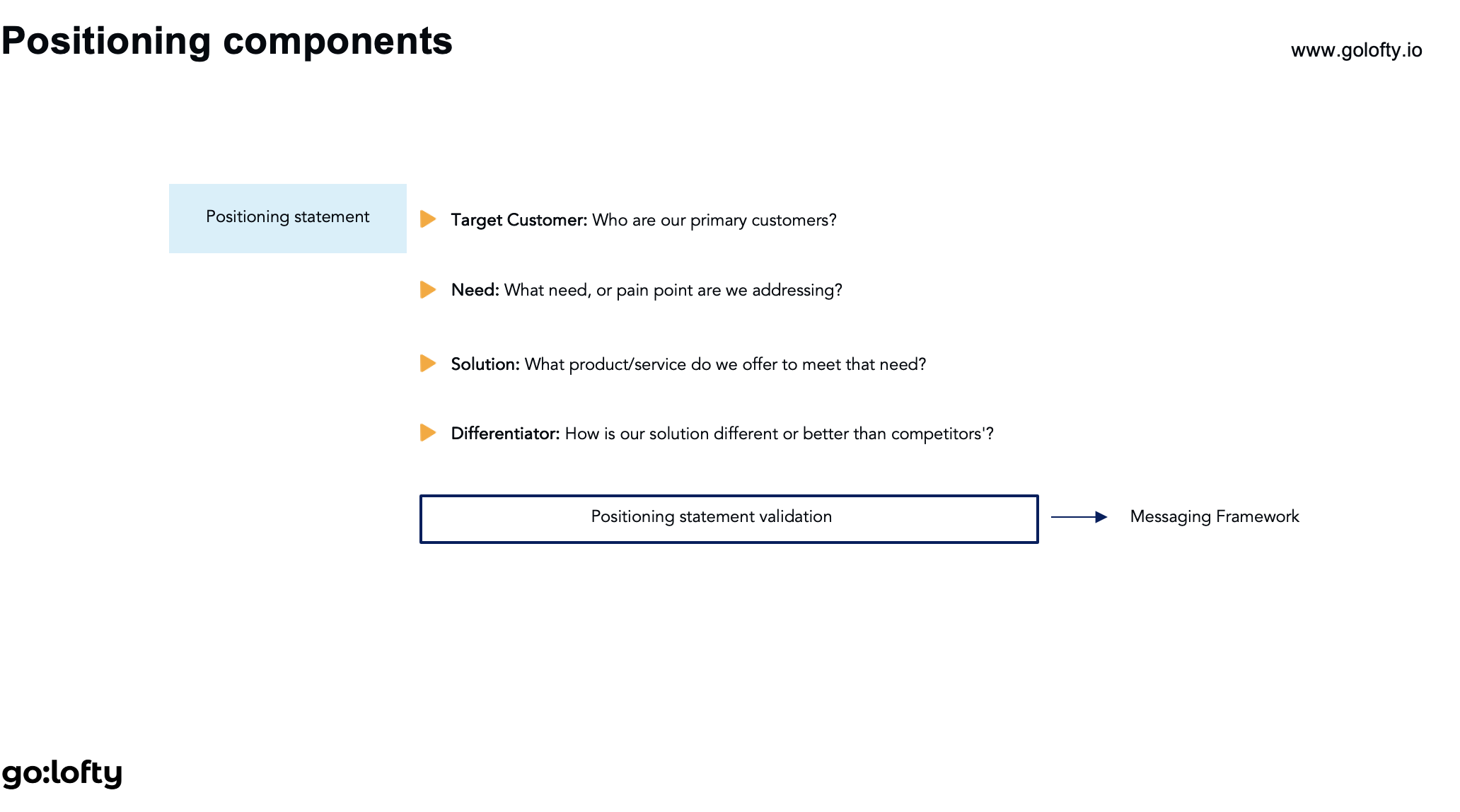
In today’s competitive business environment, a company’s success often hinges on its ability to effectively position itself in the minds of its target audience. An effective positioning strategy helps companies define who they are, what they offer, and how they stand out from competitors. The diagram above illustrates the core components of a positioning statement, showing the elements that need to be addressed to create a powerful market message that resonates with customers and guides your marketing and sales efforts.
This blog will break down these components and show you how to craft a compelling positioning statement that sets your business apart.
What Is Positioning?
Positioning refers to the process of defining how your product, service, or company is perceived in the market relative to your competitors. A strong positioning statement allows your business to communicate its unique value in a way that is clear, compelling, and targeted to the right audience. It addresses several key questions:
- Who is your target customer?
- What need are you solving?
- How do you solve that need better than competitors?
By answering these questions, a company can create a positioning statement that forms the foundation for its marketing and messaging efforts.
Breaking Down the Key Components of Positioning
- Target Customer: Who are our primary customers?
Understanding your target customer is the cornerstone of an effective positioning strategy. Without a clear idea of who your customers are, your efforts will be misaligned, and your messaging won’t resonate. Here are the key considerations:
- Demographics: Who are they in terms of age, gender, income level, etc.?
- Psychographics: What are their values, beliefs, or attitudes?
- Pain Points: What specific problems or challenges are they facing that your solution addresses?
Clearly identifying your target customer allows you to focus your efforts and communicate more effectively.
- Need: What need or pain point are we addressing?
Next, you must articulate the specific need or problem that your product or service is solving. The more clearly you can define this, the better you can demonstrate your value to your target audience. Ask yourself:
- What problem does your customer need to solve?
- How urgent or critical is this problem to them?
- How does solving this problem improve their lives or business?
Focusing on the need ensures that your offering addresses something of real value to your customers.
- Solution: What product/service do we offer to meet that need?
Now that you’ve defined your target customer and their needs, the next step is to communicate how your solution—whether it’s a product or service—directly addresses that need. Here are some points to consider:
- What does your product or service do?
- How does it solve the customer’s problem better or more efficiently than other options?
- What key features and benefits should be highlighted?
Your solution is the core of your offering, so it’s essential to present it in a way that clearly shows how it meets your target customer’s needs.
- Differentiator: How is our solution different or better than competitors’?
Finally, your positioning statement must include your differentiator—what makes your solution unique in the marketplace. Differentiation is crucial because it tells potential customers why they should choose your product or service over competitors. Consider the following:
- What unique features, capabilities, or advantages does your solution offer?
- How do you provide more value than competitors?
- Is there a niche or angle that your competitors have missed?
Effectively highlighting your differentiator is what will ultimately set you apart and attract the attention of your target market.
Positioning Statement Validation
Once you’ve created a draft of your positioning statement by addressing these four components, it’s important to validate it. This involves testing your positioning with internal stakeholders (e.g., your sales and marketing teams) as well as externally with potential customers or partners. A few key steps to validation include:
- Internal Feedback: Share the positioning statement with your team. Do they find it compelling and clear? Does it align with the company’s overall vision and strategy?
- Customer Feedback: Conduct market research to see how potential customers react to your messaging. Do they understand your value proposition? Is it convincing enough to make them choose your product or service?
Positioning statement validation is critical because it ensures that your messaging framework is both accurate and resonant with your intended audience.
Connecting Positioning to a Messaging Framework
Once you have validated your positioning statement, the next step is to integrate it into your messaging framework. Your messaging framework takes the core elements of your positioning statement and translates them into the language you will use across all marketing channels and sales efforts. This includes:
- Taglines and slogans that convey your differentiator and value proposition.
- Key messages for marketing campaigns, social media, and sales materials.
- Content themes for your website, blogs, and other marketing collateral that consistently reinforce your positioning.
A well-crafted messaging framework ensures consistency in how your brand is communicated, both internally and externally. It serves as a guide for every piece of content, ensuring that all customer touchpoints reflect your core positioning and message.
The Power of Positioning
Your positioning statement is not just a marketing tool—it’s a strategic foundation that influences every aspect of how you communicate with your customers. By clearly defining your target customer, identifying their needs, offering a clear solution, and differentiating your product or service, you create a strong market position that sets your company apart from the competition.
At Go:lofty Consulting, we help businesses craft compelling positioning statements that resonate with their target audiences and drive results. Contact us today to learn how we can help you develop a winning positioning strategy.




